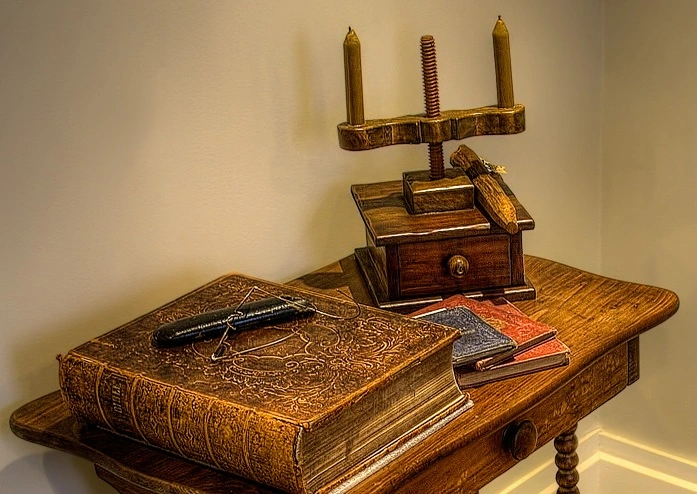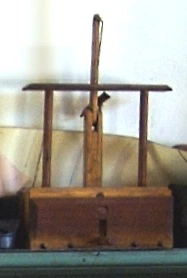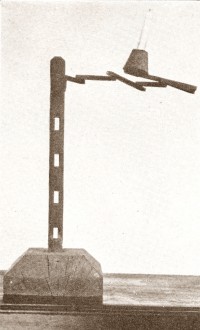
When you’re working by candlelight you want as much light on your sewing or reading as possible, but you don’t want to waste candlewax or tallow. It helps if you can raise or lower the light to suit the task, or to allow for the candle getting shorter.

Colonial Americans and their descendants left behind them a kind of threaded candlestand with a special charm. It’s thought of as a distinctively American design: twin candle holders on a wooden bar which moves up or down on a central stem. Floor-standing candlestands like this, with a small tabletop, are desirable antiques, while 20th and 21st century craftspeople have gone on making both full-height and “desktop” versions. For a classic example in maple wood look at this 18th century one in the Metropolitan Museum of Art.
Grandmother’s front room had bow-backed chairs with flag seats, and tables supported by curiously-carved and twisted legs, a candle stand that screwed up and down like a piano stool, a handsome mirror, and the buffet was resplendent in its appointments.
Memories of a Massachusetts room c1800 in Reminiscences of a Nonagenarian by Sarah Emery, 1879

What are they called?
Now for the name problem. Is there a name that summons up an image of a tripod-legged table with a pair of candle holders on an arm that screws up and down? Or even a name for the top part with or without legs? Here are some that I’ve seen used:
Candlestand or Candle Stand – the name used by the Met, but they use it for plain tables too. Light, portable tables, aka candlestands, were made in quantity in the 1800s as bedside or parlor tables suitable for holding a candlestick. Candlestand can also mean a very ornamental tall stand.
Shoemaker’s or Cobbler’s Candlestand – Adjusting the level of the candle was certainly important for shoe makers and other craftspeople, but they didn’t stick just to the threaded twin-candle type. The photo left shows a very simple candle holder with some scope for height adjustment, while the shoemaker’s shop at Williamsburg also has a more elaborate kind with the “light-focusing” globes associated with lacemaking.
Shaker Candlestand – Is it right to call screw-threaded candle holders “Shaker”? They weren’t just made by Shakers, and the Shakers themselves also made tables with a single hole and shaft for a candle holder, as well as plain small tables to place a candlestick on.
In the evening, after the dishes were washed and cleared off the table and the table set back, the candle stand would be moved out from its proper corner and the whole family gathered around it; some of the men reading a newspaper or a book or the women sewing or knitting, or spinning flax or tow. If there was not room around the stand for all, one or more would hang a candle on the back of a chair.
Memories of a Virginia farm in the 1820s by John Janney

English candlestands
What ancestors or relatives did these candlestands have in Europe? I turned to Pinto’s Treen and other wooden bygones for clues. He describes a variety of adjustable one- or two-candle holders and stands: to go on the floor, on a table, or hanging on a wall. The type that sounds most like the taller early American kind discussed here is an 18th century “threaded wood stem or pillar, on which were mounted one or two threaded candle brackets, adjustable in height by turning them on the stem”. “Ratchet adjustment” or “friction rise and fall” were alternative mechanisms. He shows an early single candle friction type, floor-standing with a small square tabletop incorporated in the design. There’s also a short 18th century boxwood candle holder with threaded shaft holding an arm with a candle at each end.
As mentioned above, there’s some similarity with lacemakers’ candlestands, which Pinto says were used not only for lace but for other “close work” too. Usually, in England at least, these were “crude”, “three-legged” like milking stools, with holes for the “flashes” or water-filled globes and for a single “spring controlled rise and fall candle holder”.
Photos
Photographers credited in captions. Links to originals here: main picture, scale model candle stand, Williamsburg candle stand. More picture info here
//
http://pagead2.googlesyndication.com/pagead/show_ads.js
For a comprehensive review of lacemaker lighting, see “Collecting: Lighting for the Lacemaker” at http://lacenews.net/2011/04/12/collecting-lighting-for-the-lacemaker/.
LikeLike
wonderful issues altogether, you simply won a emblem new reader.
What would you recommend in regards to your submit that you made some days ago?
Any sure?
LikeLike
I believe the shoemaker picture is a rat trap not a candle stand
LikeLike